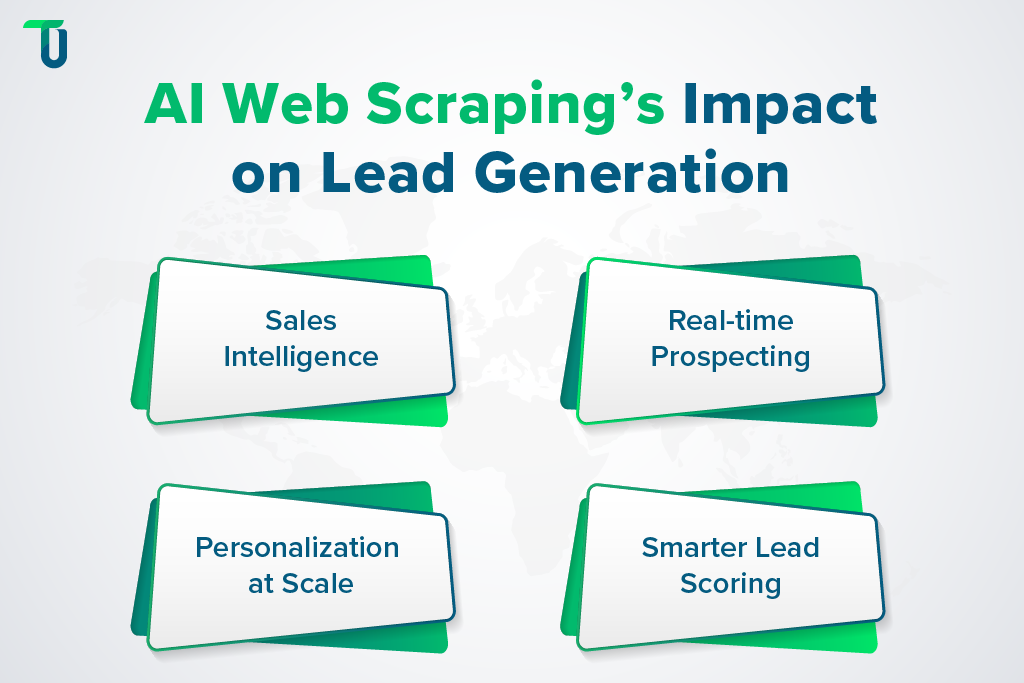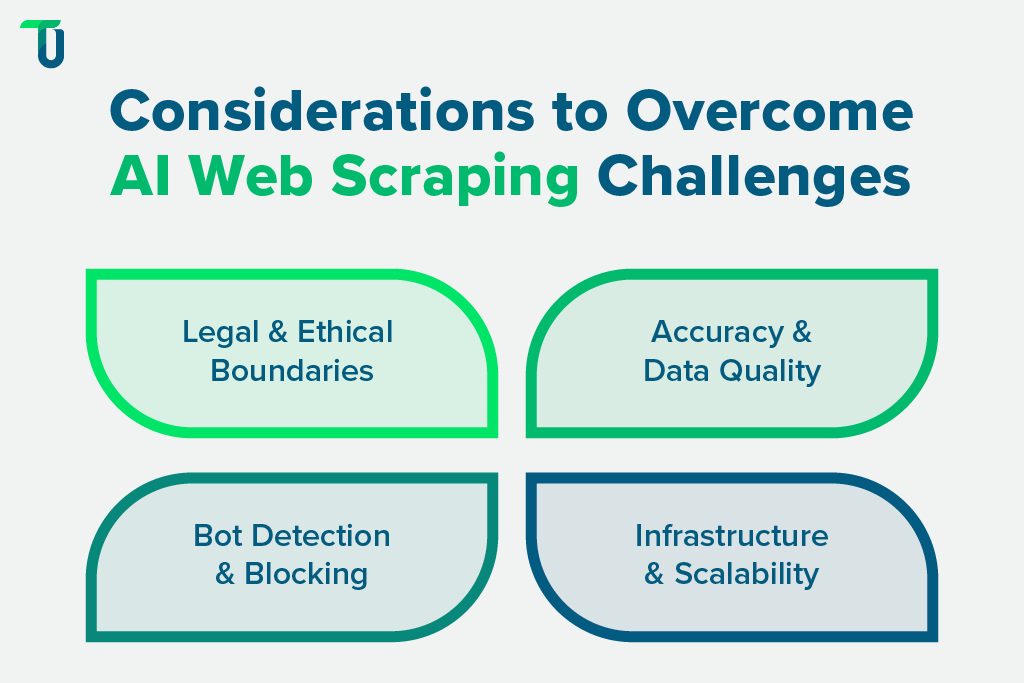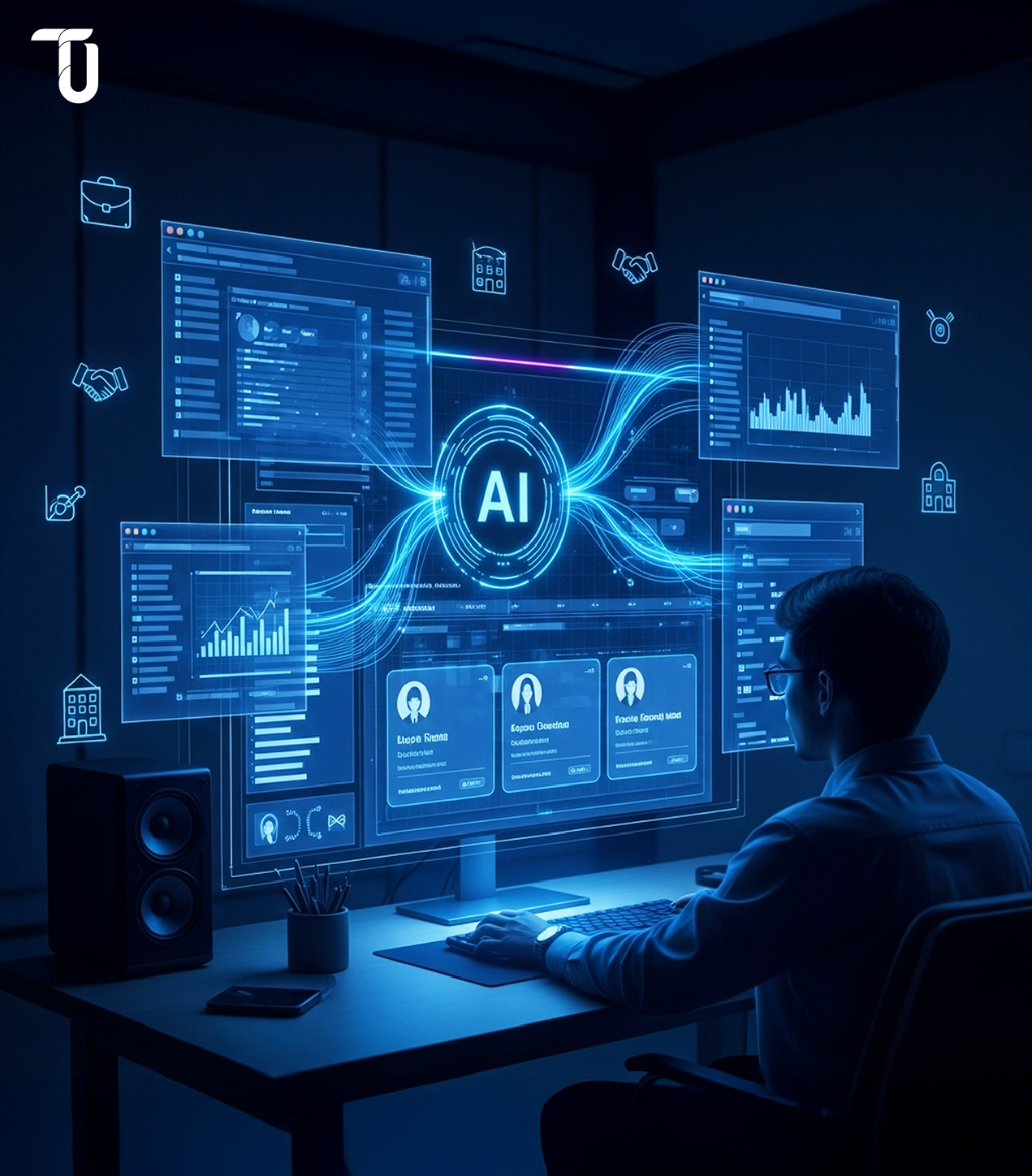How AI Web Scraping Transforms Lead Generation Pipelines
Here’s the truth most teams overlook: Lead generation isn’t a volume game anymore. It’s a relevant game.
An AI web scraper transforms your pipeline from reactive outreach to proactive engagement by unlocking real-time, high-intent data across digital channels. Instead of chasing cold contacts, you’re engaging prospects already signaling buying interest—even if they haven’t directly reached out.
Here’s how this transformation takes shape:

From Raw Data to Sales Intelligence
AI web scraping isn’t just a smarter way to extract data. It’s a strategic lever across multiple industries and use cases, especially across sales and marketing functions.
Speed-to-Lead: Real-Time Prospecting
Traditional scraping operates on fixed schedules. AI web scraping works based on triggers. If a company raises funding or changes its tech stack, your pipeline receives that insight instantly.
Personalization at Scale
By combining intent signals with firmographic and behavioral data, AI enables hyper-personalized outreach that increases conversion rates without adding complexity.
Smarter Lead Scoring
AI models can evaluate scraped leads based on buying intent, engagement trends, and company context. This helps your team focus on high-value prospects and improve close rates.
AI web scraping isn’t about adding more tools. It’s about using smarter data to build a pipeline that is faster, leaner, and more accurate.
AI Web Scraping Use Cases in Sales and Marketing
AI web scraping isn’t just a smarter way to extract data. It’s a strategic lever across multiple sales and marketing functions. Whether you're in SaaS, eCommerce, or recruitment, the right AI scraping setup can turn open web data into qualified pipeline fuel.
Let’s break down where it drives the most impact.
B2B SaaS: Automating Account-Based Prospecting
Forget manually hunting LinkedIn profiles or company pages. AI web scraping tools can track job role changes, new tech adoption, or funding rounds to flag accounts that match your ICP automatically. This helps your SDRs focus on companies with real buying signals, not just firmographic fit.
E-Commerce: Monitoring Market Signals and Competitors
AI scrapers can extract pricing, customer reviews, and promotional campaigns from competitor sites in real time. This enables your sales and marketing teams to craft more effective discounting strategies, create demand-based bundles, or adjust messaging based on trends in your segment.
Recruitment and Staffing: Finding Qualified Candidates Faster
Hiring teams can use AI scraping to scan GitHub, Stack Overflow, or niche forums for candidate profiles that match specific skills. Combine this with job board scraping to understand candidate availability, and your recruiters get high-quality leads without relying on third-party platforms.
Content and Campaign Strategy: Enriching Outreach Data
Marketing teams can scrape topic clusters, trending keywords, or influencer content across platforms to guide content calendars or campaign messaging. You’re not guessing what your audience cares about — you’re watching it unfold in real time.
AI web scraping bridges the gap between scattered data and focused action. It provides every GTM team with a live stream of opportunities, tuned to what matters most — timing, intent, and context.
Manual prospecting is costing you time and deals.
AI web scraping brings you high-intent leads, so your team stops chasing and starts closing. Let’s discuss custom development.
Getting Started with AI Web Scraping for Lead Generation
You know the "why." Now let’s talk about the “how.”
Getting started with AI web scraping doesn’t require a massive tech overhaul. Whether you’re building an internal solution or adopting a no-code tool, the goal is the same: create a scalable, intelligent lead generation workflow that connects the right data to the right decision-maker at the right time.
Choose the Right AI Web Scraping Tools
Start by picking a tool that fits your use case.
- For non-technical teams, platforms like Browse AI or Scrapy Cloud offer plug-and-play options.
- For dev-first teams, Python frameworks with AI models (like BeautifulSoup + NLP classifiers) provide custom control.
Look for tools that support dynamic page scraping, JavaScript rendering, CAPTCHA handling, and machine learning capabilities — all critical for quality lead data.
Build a Clean, Connected Data Pipelin
Scraping alone won’t move the needle. The value lies in clean, structured data that flows directly into your CRM or marketing automation platform.
Use tools like Zapier, Integromat, or native APIs to connect scraped data with HubSpot, Salesforce, or Marketo. This enables real-time follow-ups, lead scoring, and segmentation without manual effort.
Best Practices for Effective AI Web Scraping
- Always target public data sources to stay compliant.
- Use AI models to filter for accuracy and relevance.
- Set up alerts or scraping triggers based on buyer intent signals (e.g., new funding, hiring sprees, or product launches).
- Test with small batches before scaling across multiple pages or platforms.
Think of AI web scraping as the frontend of your modern sales engine. When done right, it becomes a self-refreshing stream of actionable leads, tailored to your market and synced with your pipeline.
Challenges and Ethical Considerations of AI Web Scraping
AI web scraping opens up a world of possibilities for lead generation, but it’s not without its friction points. Between legal frameworks, technical limitations, and data integrity risks, teams must navigate carefully to stay both compliant and competitive.
Here’s what to watch out for.

Legal and Ethical Boundaries
Not all data is fair game. AI web scraping tools must be configured to extract only publicly available information and comply with data privacy laws like GDPR, CCPA, and HIPAA.
Scraping gated content or bypassing authentication mechanisms can land your business in legal trouble and erode brand trust. Ethical scraping means respecting robots.txt, site terms, and human boundaries.
Accuracy and Data Quality
AI can parse complex data, but context still matters. If your scraping model isn’t fine-tuned, you risk pulling outdated, duplicate, or irrelevant information that clutters your pipeline.
Use AI models with entity recognition and sentiment analysis to increase the accuracy of scraped insights and reduce noise.
Bot Detection and Site Blocking
Many websites now deploy anti-scraping mechanisms like bot traps, CAPTCHAs, and IP rate limiting. Without proper handling, your scrapers can get blocked — or worse, blacklisted.
Solve this by using AI web scraping platforms that rotate proxies, simulate human behavior, and bypass JavaScript-heavy content ethically.
Infrastructure and Scalability
Scraping at scale without a stable backend can lead to data drop-offs or processing delays. Integrate your AI web scraping system with cloud-based storage and queue management to avoid performance bottlenecks.
Future Outlook: What’s Next for AI-Powered Lead Generation
AI web scraping is just the beginning. What comes next is a complete reimagining of how sales pipelines are built, optimized, and scaled. As AI continues to evolve, so does the way we discover, score, and engage leads.
Here’s what the next chapter looks like:
Predictive Lead Generation Becomes the Norm
AI will not just scrape data. It will begin predicting who is most likely to convert. With predictive analytics, platforms will analyze patterns in behavior, firmographics, and past conversions to surface high-intent leads before competitors even notice them automatically.
Real-Time Data Enrichment at Scale
Static lead lists are becoming obsolete. In the future, AI web scraping will support real-time data enrichment, constantly updating CRM records with the latest funding news, role changes, and engagement signals to keep your pipeline fresh and conversion-ready.
Hyper-Personalization with AI-Driven Content
With AI-generated insights, outreach will shift from broad segments to micro-personas and real-time behavior. This enables personalized emails, ads, or chatbot messages that align with a lead’s current context, improving open rates, clicks, and conversions.
Next-Gen Sales Automation
Expect tighter integration between AI web scraping tools and sales engagement platforms. The result is a self-optimizing sales funnel where scraped data automatically triggers campaigns, nudges reps with AI-recommended actions, and improves targeting through continuous feedback.
The future of lead generation is not about working harder. It is about working with smarter, self-evolving data ecosystems powered by AI. If your sales pipeline is not intelligent yet, it is already behind.
From Data to Deals: Power Your Pipeline with TenUp
The future of lead generation is intelligent, agile, and AI-driven. At TenUp Software Services, we do not just build AI web scraping tools. We engineer end-to-end data solutions that turn raw information into qualified leads and revenue-ready insights.
Using NLP, machine learning, and intelligent automation capabilities, our AI Engineering services are designed to help you extract, enrich, and activate data at scale. Whether you need custom scrapers, real-time enrichment engines, or AI-powered lead scoring models, we tailor solutions that integrate seamlessly into your GTM workflows.
Our data pipelines do not just gather leads. They refine them. And our AI models learn and adapt with every touchpoint to continuously optimize your results.
It is time to move beyond cold lists and into high-intent conversations. Talk to our experts today and unlock the power of AI-led prospecting with TenUp.
Still relying on guesswork for leads?
Start using AI web scraping to extract real-time, high-intent data that fuels pipeline growth. Talk to our AI experts.
Frequently asked questions
Can AI scraping extract data from dynamic sites like LinkedIn or Twitter?
Yes, AI scraping tools can extract data from dynamic platforms like LinkedIn or Twitter using headless browsers or automation frameworks. However, due to strict anti-scraping policies, only publicly available data should be collected to ensure legal and ethical compliance.
How do AI scrapers handle bot detection, CAPTCHAs, and anti-scraping measures?
AI scrapers overcome bot detection and CAPTCHAs by simulating human behavior, rotating proxies, and using headless browsers. They also adapt to site changes in real time, solving CAPTCHAs through AI-powered services while maintaining compliance with ethical scraping practices.
What AI tools are best for non-technical teams to scrape leads?
No-code AI scraping tools like Browse AI, Octoparse, Apify, and ScrapR are ideal for non-technical users. They offer visual interfaces, pre-built workflows, and integrations with CRMs or Google Sheets—making lead scraping accessible without writing code.
What is the cost of implementing AI web scraping for B2B lead generation?
AI web scraping costs range from $50/month for no-code tools to over $10,000 for custom solutions with CRM integration and machine learning. Pricing depends on data volume, scraping complexity, automation needs, and update frequency.
How frequently should AI scrapers update public datasets to keep lead data fresh?
AI scrapers should update datasets daily or in real time for fast-changing industries like SaaS or eCommerce. For slower markets, weekly updates work. Trigger-based scraping—like tracking funding or hiring—offers the most efficient and timely lead refresh.
How accurate are AI-scraped leads compared to manual prospecting?
AI-scraped leads are often more accurate than manual ones, thanks to real-time data, intent signals, and machine learning filters. They reduce human error, scale faster, and surface high-intent prospects—though human oversight still improves precision and personalization.
Are there open-source AI-based web scraping frameworks with NLP integration??
Yes, open-source frameworks like Scrapy, BeautifulSoup, and Selenium can be paired with NLP libraries such as spacy or Transformers to extract and analyze structured, contextual data—ideal for tasks like sentiment analysis, job parsing, or content classification.

